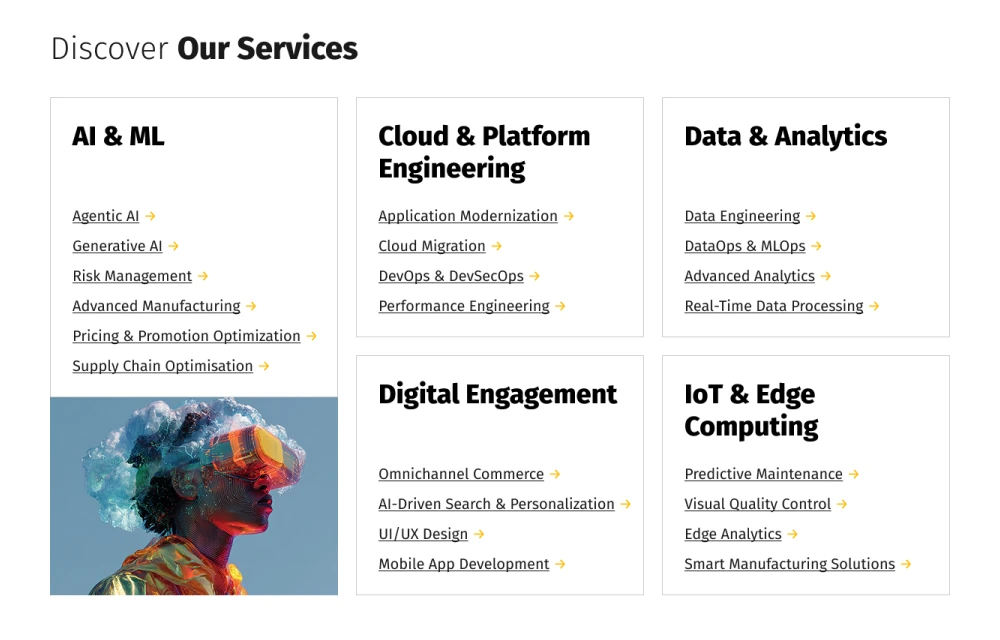Case Study: Fixing the Funnel at Grid Dynamics
October 14, 2025
Grid Dynamics is a tech company that works with some of the biggest names in the Fortune 1000. They’re listed on the S&P 600, and they specialize in advanced IT services — things like cloud transformation, AI integration, platform engineering. Serious stuff.
But between 2022 and 2025, they hit a wall.

The Problem
It started with a site redesign in 2022. The site looked better — cleaner, more modern. But it didn’t work. At least not for the people that mattered: the buyers.
After the launch, lead flow from the website fell off a cliff.
- Website SQLs dropped from 72 to just 4 by 2025.
- Closed-won deals from digital? Basically vanished.
- The estimated loss in pipeline? Over $14 million.
The pages didn’t say enough. The messaging was vague. Navigation got confusing. CTAs lost their edge. A lot of content that used to convert just… disappeared.
And worse? The company couldn’t even track what was going wrong because analytics were half-broken.
That's where we stepped in.
The Fix: 90 Days of Focus
IBA Agency was brought in with a simple goal: turn this around. But you don’t fix three years of decline in one move. We needed to go step-by-step — and fast.
Here’s what we did.
Step 1: Get Clear on What Went Wrong
Before touching a single line of copy, we sat down with the team — marketing, sales, execs. Everyone.
We mapped out the funnel. Looked at what was working in 2021 (pre-redesign). Compared it to what tanked in 2023 and early 2025. We reviewed the actual Grid Dynamics Web Plan, which helped organize internal timelines, rollout phases, and launch targets.
This gave us a baseline to work from. And yeah, it was worse than expected.

Step 2: Fix Analytics So We Could Trust the Data Again
GA4 hadn’t been fully set up. Conversions weren’t tracked. Scroll depth? CTA clicks? Form fills? None of it was visible.
We deployed GA4 through Tag Manager. Set up tracking for:
- Scroll depth (90% threshold)
- Contact and demo forms
- CTA buttons across 100+ pages
- Outbound clicks (e.g. partner links, career site)
- Video plays, downloads, site search terms
And we pulled all of that into Looker dashboards so teams could actually see what people were doing — and what they weren’t.
Step 3: Rebuild the Site — Without Redesigning It
The problem wasn’t the color palette. It was the content.
We rewrote more than 100 pages, bringing back what used to work: real value props, clear outcomes, and relevant proof points. Less fluff, more “here’s what we do and why it matters.”
We added CTAs where they had been stripped out. Tightened page structure. Re-introduced industry-specific sections and case studies that had been buried or removed.
We also fixed on-page SEO. Titles, headings, metadata — all of it got an update. Even internal linking improved.

Step 4: Relaunch Campaigns That Had Gone Quiet
We supported the relaunch of five major campaign tracks — AI, Cloud, Financial Services, Insurance, and Digital Engagement. Each one was tied to buyer personas (not departments) and mapped to a real sales play.
We helped develop:
- Email sequences (evergreen and quarterly)
- “Business Driver” — their executive newsletter
- 60+ content assets: whitepapers, demos, case studies, pages
This wasn’t blast-and-pray. It was targeted. Personalized. Tracked.
Step 5: Equip the BDR Team to Actually Use This Content
We rebuilt their Outreach.io sequences from scratch. Each sequence had 7 touches across email, LinkedIn, and optional phone steps. Messages were tied to intent signals: pages viewed, links clicked, content downloaded.
We also rebuilt the lead scoring model.
Someone clicking 10 links and visiting the Contact page was worth more than someone just opening emails. We gave points for the right behaviors — not just activity volume — and pushed high-fit contacts to the BDR team within 24–48 hours.
The Outcome: It Worked
Within 90 to 120 days, things changed. A lot.
- Website SQLs went from 4 to 28
- Opportunities jumped from 2 to 12
- Average engagement rate more than doubled
- Bounce rate dropped from 72% to 31%
- CTA conversion rates climbed to over 7.5%
- Event count (user actions) grew 95%
Even better: nearly 91% of pages showed better engagement. That tells us the content changes weren’t just working in a few spots — they were working everywhere.

What We Learned
Sometimes the biggest problems aren’t technical. They’re clarity problems.
Grid’s site didn’t need to be fancier. It needed to say the right things, to the right people, at the right moment — and then track what happened.
By fixing content, campaigns, analytics, and outreach all at once, we didn’t just boost traffic or impressions. We rebuilt the sales funnel.
One page, one lead, one CTA at a time.